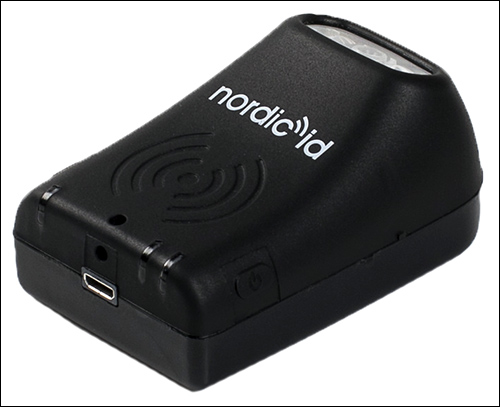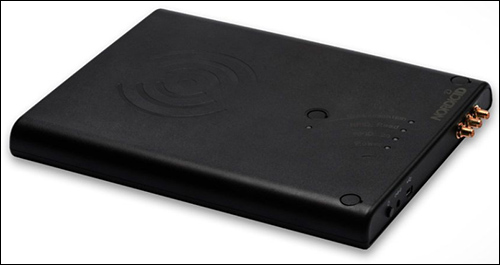Radio frequency identification technology company Nordic ID has released a new series of ultrahigh-frequency (UHF) fixed and mobile readers intended to make RFID deployments faster, easier and more effective for retailers, logistics companies and manufacturers. The readers include fixed devices that can interrogate up to 1,000 tags per second, and two small handheld devices that can be tethered to smartphones. The new reader series, says Juha Reima, Nordic ID’s CEO, provides users with technology that is faster to install due to the readers’ built-in intelligence, and offers greater flexibility in form factors, as well as faster reads.
“We have seen a trend where users need increasing intelligence on their devices,” Reima says. Rather than forwarding the large volume of read data to a server, he explains—which can prove time-consuming during read events, as well as make for a more complex installation—the management of read data locally on the reader makes a system more efficient and secure.
The new reader series includes Nordic ID’s EXA31 and 51e—both handheld devices designed to be very small. The EXA31 can be worn on a glove or on a lanyard around a person’s neck, or simply be placed inside a person’s pocket. The Nordic ID Sampo One series and Sampo S2, as well as the AR85 and AR82, are fixed readers designed for gates, the point of sale or real-time area coverage.
The EXA series, the company reports, brings portability to RFID reading in the form of devices that are smaller than traditional handheld readers. The EXA31, which is approximately the size of a matchbox, is built to be compact and lightweight. It can read tags at a distance of about 7 feet (2.1 meters), then forward that data to an iOS or Android device via Bluetooth Low Energy (BLE). The smartphone or tablet can use Nordic ID’s app or another app designed for the purpose of managing the collected read data. It also includes LED, vibration and buzzer indicators, enabling users to understand each time a tag is being read. The battery can be recharged with a USB connection.
The use case for the EXA31, Reima says, may be in a store or warehouse in which employees must seek a specific item using a Geiger counter mode, or ensure a close read range to create a record of which components or materials an individual operator has handled. In the case of a retail application, a customer could be seeking a specific garment or pair of shoes. A store associate would input that item into the app on his or her phone or tablet, then walk around the department equipped with the UHF reader. The device would signal when the requested item came within range. “That application,” he says, “could solve a problem in which customers leave the store when they don’t find the product they came for.”
The EXA51e is a larger version of the EXA31, with a longer read range, greater sensitivity and a faster reading speed. It, too, connects to a smartphone via a BLE connection, can capture UHF RFID tags at a distance of up to 33 feet (10 meters) and can be dialed down to a half-inch. The 51e offers additional read speed, enabling the reading of 1,000 tag IDs per second. It can be attached to a sled for reading purposes and has up to 14 hours of life with intensive usage.
The 51e version of the EXA reader is designed for the receiving of mass inventory, as well as the locating of items in a crowded RFID environment. For logistics and manufacturing, the EXA51e can be used to manage picking operations or heavy-duty data collection in warehouses.
For fixed reading, Nordic ID has released its Sampo S2 and S2 One series—fixed UHF RFID readers with multiple connectivity choices. The Sampo S2 series operates at both U.S. and European frequencies within the UHF band, and is typically intended for use by retailers at the point of sale or at gates. It comes with an integrated computer to manage data in the machine, requiring less transfer of data to the cloud.
The Sampo S2 and One series come with Nordic ID’s NUR2-1W reader module and three external antenna ports. The reader can forward data via an Ethernet connection, dual-band Wi-Fi or a 3G cellular network. It comes with internal wideband UHF antennas, but enables the connecting of up to three external antennas as well.
The Nordic ID AR82 is a fixed reader with a built-in computer and 16 ports for antennas, enabling multiple reader gates to be managed by the single device. That number of antenna ports enables it to be used for shelf reading, and it can interrogate tags at a speed of 1,000 tags per second. It comes with multiple communication options, such as Ethernet, dual-band Wi-Fi and 3G cellular. The AR82 is designed for automated in-store inventory management, or for asset management within an office, an assembly site or a warehouse. It can also be used to manage the locations and movements of individuals wearing RFID-enabled badges.
The AR85 covers a larger reading area without requiring any external antennas. It is suitable, Reima says, for RFID-based gate solutions and monitoring a designated area. The readers that offer the 1,000-tags-per-second read rate are approximately twice as fast as predecessor readers, the company reports.
The new readers are built to be affordable, according to Reima. The EXA31 is priced at €830 to €980 ($973 to $1,148) while users will pay €1,190 to €1,390 ($1,395 to $1,629) for the EXA51e, and €830 to €1,170 ($973 to $1,371) for the Sampo S2 One. The AR85 is provided at €1,630 to €1,890 ($1,910 to $2,215) and the AR82 will sell for €1,390 to €1,650 ($1,629 to $1,934.
The company has also released its Nordic ID Radea software platform to manage UHF RFID or bar-code devices. The software interprets and manages read data, then forwards that information to a user’s own back end or to cloud-based software.
Multiple companies are already deploying some of the new reader products, according to Nordic ID. These include a large automotive manufacturer that is using the EXA31 on its assembly lines to manage which components are being used during each assembly operation, and a chain laundry business using Sampo S2 reader gates to read tags attached to work wear.




